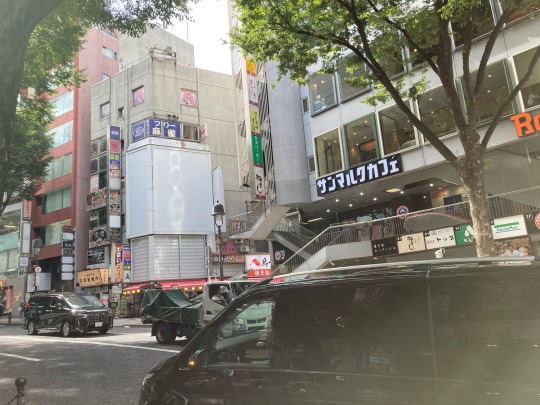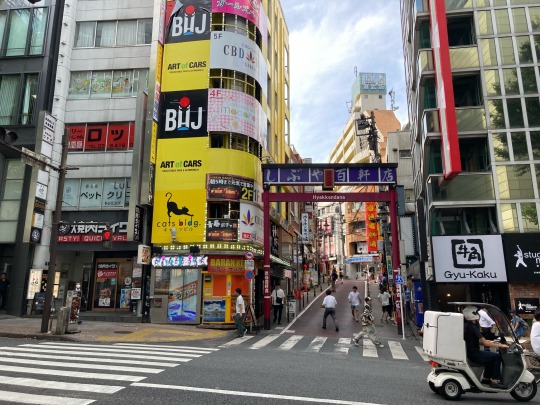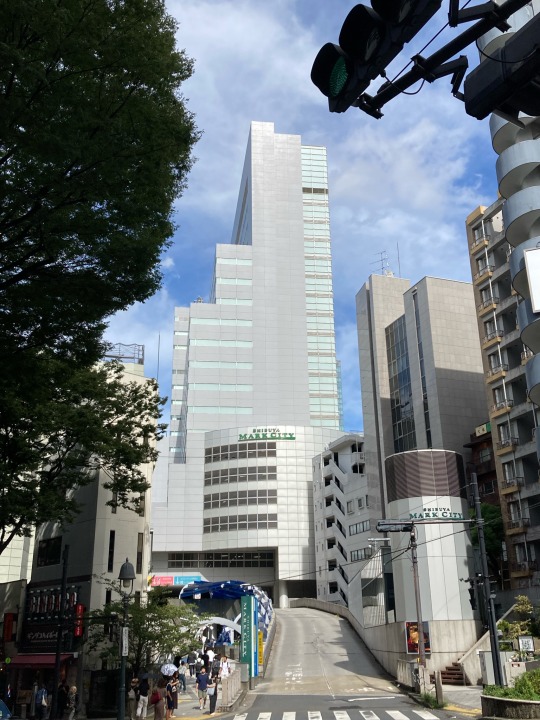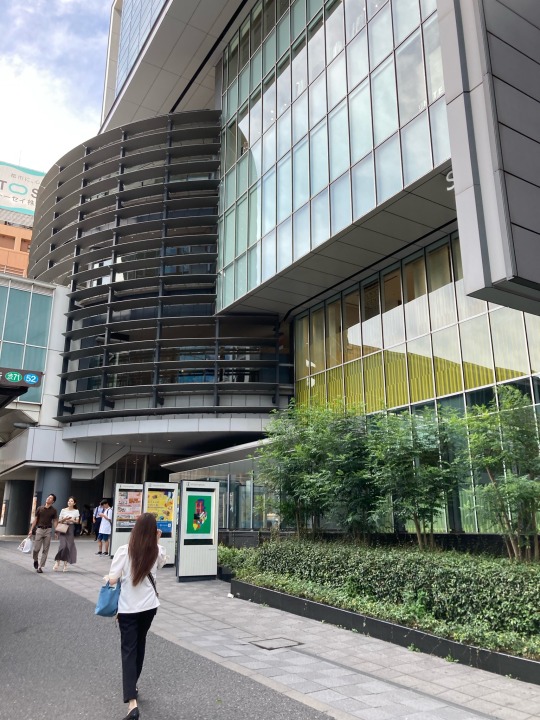#i mean we made it to tokyu plaza and takeshita street the other day but i wasn’t paying attention to the route we were taking
Text
pov a huge twewy/ntwewy nerd visits shibuya part 2
ramen town baby!!! yeah i was not about to climb that whole hill even though it really wasn’t that steep. dogenzaka beloved


you only visit this place once in the main game but there are so so many things i could say about it. man the neku-josh-sho week 2 dynamic was the wildest and funniest thing in the world

spain hill (from above) (idk uhh what’s iconic about here?) (i didn’t trip on any haunted step that much i know)

the vibes of this place… not accessible until so late in the game (in both games) but so good both times. like the story beats that happened here were always excellent. i always loved being at shibuya stream in ntwewy it was beyond surreal stepping out of the station and just actually being here irl


le susukichi boss fight (and some more cool puzzles)

shibuya hikarie! not much to say here but the food you find here in ntwewy looked so good man i need to actually eat more while here

there are a few more actually oops! part 3 momentarily
#peach rambles#twewy#the world ends with you#neo the world ends with you#ntwewy#neo twewy#subaseka tag#mine: twewy#yeah sorry og twewy but ntwewy was a much stronger representation of what this town looks like#the twewy map was so confusing honestly#the 3D really helps in this case#only things i still could not instinctually find were o-east and udagawa#i didn’t find cat street but i think i would’ve if i had kept going i just didn’t feel like it#i mean we made it to tokyu plaza and takeshita street the other day but i wasn’t paying attention to the route we were taking#maybe we took part of cat street idk#i’m just thinking about the first time ya visit cat street in twewy and that fake mission lol#y’know it didn’t feel like it took me that long to get across all the corners of town#sure it was far away but like#y’know if you were walking and dealing with huge crowds and also trying not to be rude yeah it would take you wayyy more than fifteen min#but like neku was a ghost he didn’t have to worry about other people or his own physical stamina right#i feel like fifteen minutes was a doable challenge maybe?#if he’s running and has no physical drawbacks and also knows where he’s going already
64 notes
·
View notes
Text
Tokyo (2018 & 2019)
This entry is split into 2 parts: for a rather thorough trip in 2018 and a more casual trip in 2019. Both took place in September for less than a week.
2018 TRIP:
A 5D4N trip in the first week of September 2018. This is our second time to Tokyo, after a previous trip which saw us visiting Osaka, Kyoto and Tokyo.
WEATHER:
A typhoon that affected Osaka and Kyoto was not an issue, and neither was an earthquake that hit Hokkaido and Sapporo. Amazingly, it did not even rain during our trip despite weather forecasts predicting so. However, Tokyo was very hot and humid on some days. The heat was quite unbearable on a Saturday when we explored Harajuku.
TRANSPORT:
Took ANA airlines to Narita Airport, and the Express train towards the city
We bought a 3 day metro pass. You must have your passport with you when you buy this metro pass sold at specific metro stations. Buy as soon as you can, if not it will be troublesome to buy tickets whenever you take the train.
ACCOMMODATION:
Innsomnia Hotel. 2 types of train stations near this hotel. The one about 6min away is a Tokyo Metro station named Tameike-sanno. The nearer one 2min away is Akasaka station. Depending on our destination, we used either of these stations to set off each day.
There’s a trendy and popular Unir cafe next to the lobby on the ground floor, and hotel guests can get free coffee daily. The hotel barely has any facilities, and the tiny gym had no free weights. However, our room was large, with a proper sofa and TV area apart from the bed. Bathroom was old though. Location-wise, it’s in the Asakasa area, which is quiet on weekend mornings, but vibrant at night without being overwhelming. A pleasant stay on the whole.
DAY 1:
21_21 Design Site: a hip art exhibition space located within Midtown Garden. There is a nearby mall with many food options.
Ninja Akasaka: dinner at this incredible ninja-themed restaurant. Waiters are literally dressed as ninjas, and the place fascinates with its interior design while serving excellent elevated Japanese food. A must-visit even though it’s pricey.
Mixology Akasaka: had post-dinner drinks here. Small but cosy bar, serving creative drinks.
DAY 2:
Ueno Park: a scenic and spacious public park ideal for long walks. A lake covered by lotus leaves was stunning. There are torii gates for good photos too
Kyoshuku Toban: simple lunch at a classroom-themed restaurant. slightly amusing due to the setting, but don’t expect great food.
Senso-ji Temple: one of the more famous temples in Tokyo, which we did not visit on our previous trip. expect many tourists, but still worth a visit as the temple is in the heart of an area that’s charming in the evening
Don Quijote, Asakusa: An entire building dedicated to this budget shopping chain, where we bought things like caps for low prices. This whole Asakusa area is surprisingly vibrant at night.
DAY 3:
Bills Ginza Tokyo: high-end restaurant where we had fluffy pancakes for breakfast. gorgeous interior and excellent service, but pricey
teamLab Planets Tokyo: a highlight of our trip. Basically, we spent a couple of hours being fascinated by art and light installations in a warehouse-like facility. For example, one huge room had water that came up to our knees, and we were fascinated by images of colourful fishes projected onto the water. Another room was charmingly filled with giant white balls we had to push around, and another required us to lie on the ground and look at a dome-shaped ceiling that had all sorts of images projected onto it. We had to queue to buy tickets and wait to enter. This seems to be a very popular attraction in Tokyo this year, and there is more than one venue for the experience. Google “teamLab Planets Tokyo” to find out more.
Maricart Roppongi: THE HIGHLIGHT OF OUR TRIP. Basically, we made a booking with this Maricart company before flying to Tokyo, to dress up as Mario characters while driving go-karts around downtown Tokyo. This is a once-in-a-lifetime experience that you should try if you have a driving licence. You must also apply for an International Driving Permit before making the booking. We booked a 2hr experience, which included rental of the Mario/Luigi costumes we wore to drive, watching a quick instructional video, driving on roads and EXPRESSWAYS (!!!) during peak-hour traffic on a Friday evening, and a short toilet break at DiverCity Tokyo Plaza. It’s not an activity for the faint-hearted, as we literally drove next to all types of vehicles on the expressways. Driving at 60-70km/h on a go-kart that’s so near to the ground can be quite daunting. There were 4 other tourists, and 2 staff at the head and end of our convoy to guide us on the roads. Note that we were neither given safety helmets or had seat belts. BUT it was so fun and exhilarating, and I’ll remember this experience for life.
DAY 4:
Hedgehog Cafe & Pet Store HARRY Harajuku: Spent an hour petting and feeding hedgehogs in this cafe. The hedgehogs are as cute as you would expect, but after a while, we felt bad for disturbing them just so we could take photos.
Takeshita Street: Began exploring Harajuku from the entrance at this street. We spent several hours in Harajuku, eating, shopping and exploring. Expect trendy shopping options and fashionable Japanese shoppers.
Tower Records, Shibuya: walking distance from the famous Shibuya crossing. Bustling downtown area that’s great for a night out.
Kitsune: LGBT-friendly establishment that served excellent and creative sushi dishes. It’s also a dance club, but we did not stay on to party because the music was strangely soft.
DAY 5:
The Salty Sun: Australian cafe within Akasaka Biz Tower, where we had a satisfying breakfast
Shinjuku: shopped around Keio Mall and had lunch at another nearby mall named Mylord. This is a very busy shopping area, so expect crowded train stations, but it’s a good place to spend a few hours shopping and eating from mall to mall. (Note to self: Southern exit of train station area brings us to Takashimaya/Times Square area, which we visited during our first trip to Japan, but not this time)
2019 TRIP:
A trip from 9th - 13th Sept 2019. This is my third time to Tokyo, which explains why I took a more casual approach to planning and sightseeing.
WEATHER:
The powerful Typhoon Faxi hit Tokyo on the night before our early morning Delta Airlines flight. Historic winds were reported. Although our flight was not cancelled, a very epic experience awaited us at Narita Airport. To cut the long story short, we were stranded in the airport after arriving around 2pm. The airport was cut off from the rest of Japan, with no trains, buses or taxis allowed to leave or arrive at the airport. We experienced a lot of uncertainty and tension, only managing to rush onto a final train that left the airport at 10pm. This chaotic day made international headlines, with media eventually reporting that as many as 17,000 passengers were trapped in the airport, with many having to spend the night there. On the bright side, weather was kind to us for the rest of the trip. Sunny, but not as humid as it was in 2018. We barely experienced any rain too. Normal weather led to Narita Airport functioning normally when it was time to go home.
TRANSPORT:
For this trip, we flew by Delta Airlines. Air ticket cost was reasonable at $544.30 and we were happy with the overall service. Unfortunately, Delta Airlines has made headlines for ceasing business in Singapore by the end of 2019.
Due to the airport chaos, we did not manage to get a 3 day metro pass upon arrival this time. We simply bought train tickets whenever we had to use the train during the trip. However, being in Tokyo for a third time has made me better at using the trains now. In general, just remember that the JR line is the most common one, but there are other lines run by other companies. The next thing to note is that standing at the right train platform doesn’t mean you will board the right train. This is because there can be limited express trains which skip particular stations. You need to pay attention to the screens on the platform or on the train itself, to ensure that you do not board these limited express trains by mistake, if they are going to skip the stations that you want to get to.
ACCOMMODATION:
In relation to what I just wrote above, I think it’s better to book hotels that are near JR train stations. For this trip, I booked 2 such hotels, which made getting to tourist areas and back to our hotel more convenient than it was in 2018.
First hotel was Hotel Niwa Tokyo, in the Shinjuku area. Second hotel was Hotel Shibuya En, in the Shibuya area. Both these areas are served by JR train stations of the same name, and are popular tourist areas. So in terms of location, we were happy with both these hotels.
Hotel Niwa Tokyo cost about $200 a night (we booked 2 nights) and Hotel Shibuya En cost about $300 a night (we booked 3 nights). Hotel Niwa Tokyo’s room could be bigger, but there was a fitness room with treadmills. Hotel Shibuya En’s room was bigger, and bed was excellent. But room toilet was very small, and there was no fitness room. However, the basement of Hotel Shibuya En has one of the best eateries we went to on this trip, named 35 Steps Bistro, which we highly recommend for a modern and chic izakaya experience.
DAY 1:
Shinjuku: Takashimaya/Times Square area, where we spent several hours shopping and browsing the many floors of Tokyu Hands. The food hall basement of Takashimaya is always worth checking out, and we stumbled onto excellent coffee at the trendy Blue Bottle Coffee Shinjuku Cafe. It’s easy to stroll from one mall building to another in this shopping area.
Tokyo Dome: We spent the evening here, basically a stadium and amusement park area rather near our Hotel Niwa Tokyo. Dinner was excellent fast food at Shake Shack Tokyo Dome (no queues like in Singapore), and the area was conducive for an evening stroll, looking at ferris wheels and people coming to watch baseball games in the stadium.
DAY 2:
Shibuya: Loft Shibuya is the largest branch of Loft in Tokyo, which is a lifestyle store I love that also exists in Bangkok. It was within walking distance of our Hotel Shibuya En, and one of many shopping highlights in a bustling shopping district. The world-famous Shibuya Crossing is nearby too, along with Tower Records Shibuya, Mega Don Quijote (basically a massive Don Don Donki) and the usual high street fashion options like Zara and H&M. It’s possible to spend hours in places like Loft and Mega Don Quijote, if you’re excited by their wide range of products and often reasonable prices.
Food options are aplenty too, since there are so many malls and streets that make the area vibrant. Dinner was a cosy basement eatery named 渋谷 居酒屋 九四六屋 near our hotel.
DAY 3:
Harajuku: Breakfast was at the hipster haven named Bills, located in Tokyu Plaza Omotesando Harajuku. In 2018, I visited the Ginza branch of this same cafe chain. The famous fluffy pancakes are available in both, but note that this Harajuku branch is less posh than the Ginza one, understandable since Harajuku is popular with youths and Ginza is a more high-end district.
The afternoon was spent exploring the streets of Harajuku. Harajuku is a sprawling area which you can spend hours exploring. There are busy areas with throngs of tourists and tacky food or clothing options, but there are also quiet lanes with tasteful shops. If you’re travelling in September, dress light on the day you are visiting Harajuku, because it can get very hot and it’s not the kind of area with huge air-conditioned malls to hide in.
We then popped over to Meiji Jingu (Meiji Shrine), right beside the Harajuku train station. This is a good place to retreat to when you feel overwhelmed by the Harajuku crowds. It’s also arguably one of the most famous shrines in Japan, offering you a relaxing walk below tall shady trees, before you end up seeing the main shrine buildings further in. For each shrine I visit in Japan, I tend to partake in the common rituals of washing my hands/face at the water points at the entrance, followed by praying/clapping/bowing after throwing coins at the main praying areas.
Dinner was at the excellent 35 Steps Bistro I mentioned earlier, coincidentally at basement of our Hotel Shibuya En. Dishes like cheese tofu with honey, dry udon with kimchi, were innovative and impressive. Exact address is 1-1 Maruyamacho, 渋谷区 Shibuya City, Tokyo 150-0044.
DAY 4:
Akahibara: a district famous for selling all types of electronics and gadgets. Basically shopping haven for geeks and gamers. We walked around casually after alighting at the station, bought wireless chargers, and ended up visiting one of the shrines nearby. Lunch was a highlight, when we had an excellent French-inspired set lunch at a lovely cosy restaurant named Nous (2-10-8 Sotokanda, Chiyoda 101-0021), run by a very competent pair who seemed like husband and wife.
Asakusa: The afternoon was spent here, mainly visiting Tokyo’s oldest temple named Senso-ji and the streets surrounding it. This temple is very crowded, with tourists wanting to take photos with the iconic red lanterns, and buying snacks from shops lining the streets. The surrounding area is full of shopping lanes to explore too. There is also a Don Quijote (basically Don Don Donki) in the district.
Roppongi: Ended the night by taking a train here. Instead of exploring the usual high-end mall area, we ended up walking along the streets, and selecting a BBQ eatery to have dinner in. Normally, people come to this area for the high-end shopping. This area is relatively near Shibuya, which is why we chose to end our day here. Asakusa and Akahibara are significantly further from Shibuya.
Note: Because of being stranded in the airport upon arrival, we only arrived at our first hotel around midnight on Day 1. So what was technically Day 2 is described as Day 1 here. Our last day was also mainly spent making our way back to the airport from Shibuya by the Narita Express train, so I did not include details here.
Random thoughts:
Comparing Seoul and Tokyo after visiting both in 2019, I’ve realised that people in Tokyo are really much nicer. This applies to service staff in shops and eateries, strangers on the street or commuters in train stations. Food quality and variety is also definitely better in Tokyo than Seoul. However, Seoul is superior when it comes to buying facial products and hipster cafes.
0 notes